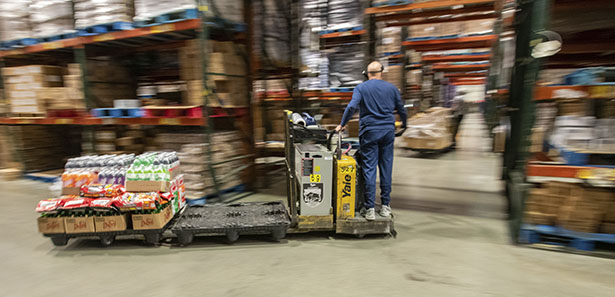How Food City pulled together around its Abingdon distribution center to handle the unprecedented challenge of the COVID-19 crisis
by Scott Robertson
While many of the region’s businesses were deciding whether to find ways for their employees to work from home during mid to late March, grocery stores did not have that option. Business boomed, and because everyone has to eat, grocery stores became the most essential of all retail businesses. Unfortunately, the increase in demand did not arrive in an orderly fashion.
Nowhere was the crazy-quilt of surges and product runs more instantly or intensely felt than at grocery distribution centers (DCs) like the K-VA-T Food Stores (Food City) center in Abingdon, Va.
When The Business Journal first asked to visit the Food City DC on March 17, we were politely but firmly told it wasn’t a good time. When the company allowed the Journal to tour the facility on May 12, we learned why that had been the case.

“March 11 was D-Day for us,” explained Shane Estep, assistant director of distribution. “We came in that morning and these guys saw a pretty significant uptick in the average case count for our stores. So, it actually hit our stores on Tuesday the 10th and all of a sudden within the next few days we started seeing stores literally ordering over double their normal case count. And then it went insane. We had supervisors in this building, for instance, work 26-27 hours straight. We had associates working 14, 15 hours. They’d go home for a nap and come back in and start another 14- or 15-hour shift. We did that for about five or six days and then we started having mass hirings.”
To understand why it would not have been advisable, or even safe, to be in the DC in mid-March, one must first understand the 520,000-square-foot beehive of activity the DC represents. More than 100 power jacks and forklifts buzz in and out of the long aisles at speeds that, for a newcomer, take some getting used to. The drivers are, “on an engineered labor standard, so they get paid by the second,” Estep said. “The faster they go, the more they get paid.”
Now, add to that whirlwind of activity the fact that around St. Patrick’s Day, the DC was adding scores of new employees. “In the middle of all of our mass hirings, Steve Smith (Food City president and CEO) went and got hold of all of our retail operators – our VPs and our DMs – they put together a force of 95-plus store associates who had never worked DC but were willing to come here,” Estep said. “They spent five weeks with us on average. We trained them up in a hurry. We didn’t care how fast they picked. We just needed them to be able to pick accurately. I don’t know what we would have done without that initiative from Steve. And for our folks here to see that commitment from our company to give us almost 100 store people to help us, it was a morale boost.”

“It’s a busy, busy place and you want people to be safe and know what to do,” said Greg Johnson, dry warehouse manager. “So, we were constantly training. We had people who hadn’t been here that long themselves training the newest people. That was so complicated, trying to train that many people. It was almost like riding a bucking bronco every day, just trying to stay on its back.
“It was an incredible thing to see 180 people – and that’s just selectors, not forklift drivers – trying to train. That was as challenging as anything we did, but we were very fortunate our HR people did a good job of screening folks and we’ve had incredible success. They haven’t had any major accidents and they’ve continued to improve.”
Even with the added manpower, some employees still worked 100-hour weeks, said Tony Waugh, dry warehouse assistant manager. “We were basically working double shifts all the time. These guys were scheduled to work four days a week and a lot of them were working double shifts six or seven days a week.”
Food City management brought in the culinary department to feed the DC staff every day, Johnson said. “The company took care of our folks like nobody can explain, so that was a blessing to us. It went on for weeks, and it was not just burgers and fries.”

Unprecedented demand
The increased staffing was driven by demand surges unlike anything seen before, Johnson said. “The first thing we had a run on was disinfectants, and then it was paper products and then canned foods and pastas. We had one employee tell us his wife was in a store and saw a guy going down the aisle with a buggy, taking his arm in the canned vegetables and just raking stuff into the buggy. He didn’t care what he got. He just got a lot of it.
“Then, about a week and a half after all that chaos, it switched over our perishable department. Beef, poultry and dairy products started selling off the shelves fast. Once all that got filled, they cancelled schools, and then the frozen products out of our freezer warehouse started flying off the racks. Then it circled back around.
“Every building has experienced something with perishables. You know, we’ve had runs on milk. We’ve had runs on water. Produce has taken a major hit during some weeks through this with receiving. It’s been interesting to say the least.
“Normal store orders coming out of this building had been about 1,300 cases,” Johnson explained. “As we got deeper into this, we got to the point where stores were ordering 12,000 – 13,000 cases on one order. We’re talking about eight or 10 trucks of product. When we fill a store up, you’re probably looking at around a 10,000 – 12,000 case range. We had stores ordering that much. That tells you just how empty some of those stores were. It’s amazing to see a store turn over 12 or 13,000 cases in a day.”
Supply chain management became an almost non-stop process. Strategies had to be altered and modified every day, and often multiple times per day.

“We have daily discussions,” Estep said. “Daily, we get on a couple of phone calls with procurement. Steve Smith is on there all the way down through the chain of command and we talk about what happened yesterday, what’s coming, what the news is saying, what we need to do today. There were some days early in this thing when we were literally changing delivery schedules a couple of times a day. We were constantly looking at the number of deliveries the stores got.
“Then, when some products stopped coming in, we started talking about what stores were going to get which products and which stores weren’t. Just the scope of sales volume across the company changed. Stores that had been leading the company in sales all of a sudden weren’t. Stores that had never gotten close to that mark all of a sudden were leading the company.”
With so many unpredictable factors, the strategies went back to basics, Estep said. “We would start calls out by saying, ‘how much can the DC push out today?’ and depending on staff, we would give them a number. We’d say, ‘This is how many people we have and this is what they’re picking per hour right now. So, at the end of the day, we can push out this many cases.’ From that, our operators – our DMs and VPs on the retail side – would start making decisions on which stores would get deliveries that day. It was the first time in the history of our company we’d ever had to do that, and we did it for more than 40 days.”

before teleconferencing.
The current situation
The runs on product have died down now and store volumes are returning to levels nearer normal, though some manufacturers have decided against producing certain product lines for the foreseeable future. The new challenge is simply dealing with out-of-stock items. For instance, in a DC with literally tons of some items, we walked by a nearly empty area with only a single palette of paper towels.
“Our stores truly have what we got,” Johnson said. “What’s coming down the highway from manufacturers and carriers to our buildings has kind of stabilized, but we are still waiting for that day when we come in and we are actually receiving product that’s still out. It’s gradually happening. Every day our stores get a little fuller with the stuff we haven’t had for the past two months.”
The problem items that are still hardest to bring in on a reliable basis? “It’s still disinfectants,” Johnson said. “It’s still paper. It’s still a little on the canned goods. The third phase of this – they just destroyed canned goods. I mean everything. Even odd items that don’t normally move that well – they just bought everything.”
Food City’s procurement staff has expanded the number of brands the store sells in order to keep shelves stocked. Customers may not recognize a new brand of toilet paper or paper towel, for instance, but they know they need toilet paper, so nobody’s complaining too much.
“The big battle outside this building right now is what’s going on with meat, especially poultry and beef,” Johnson said. “That’s the big challenge. It’s the new battlefield. You know, we can’t talk a whole lot about our buying strategy, but I can tell you that the folks we have in that area of our company who are looking for and buying meat products have just done a tremendous job of finding something these customers can use to put in those meat cases. You can see that with our competitors. It may not be the type of poultry you’ve bought for the last five years, but there is going to be poultry in that case.”




